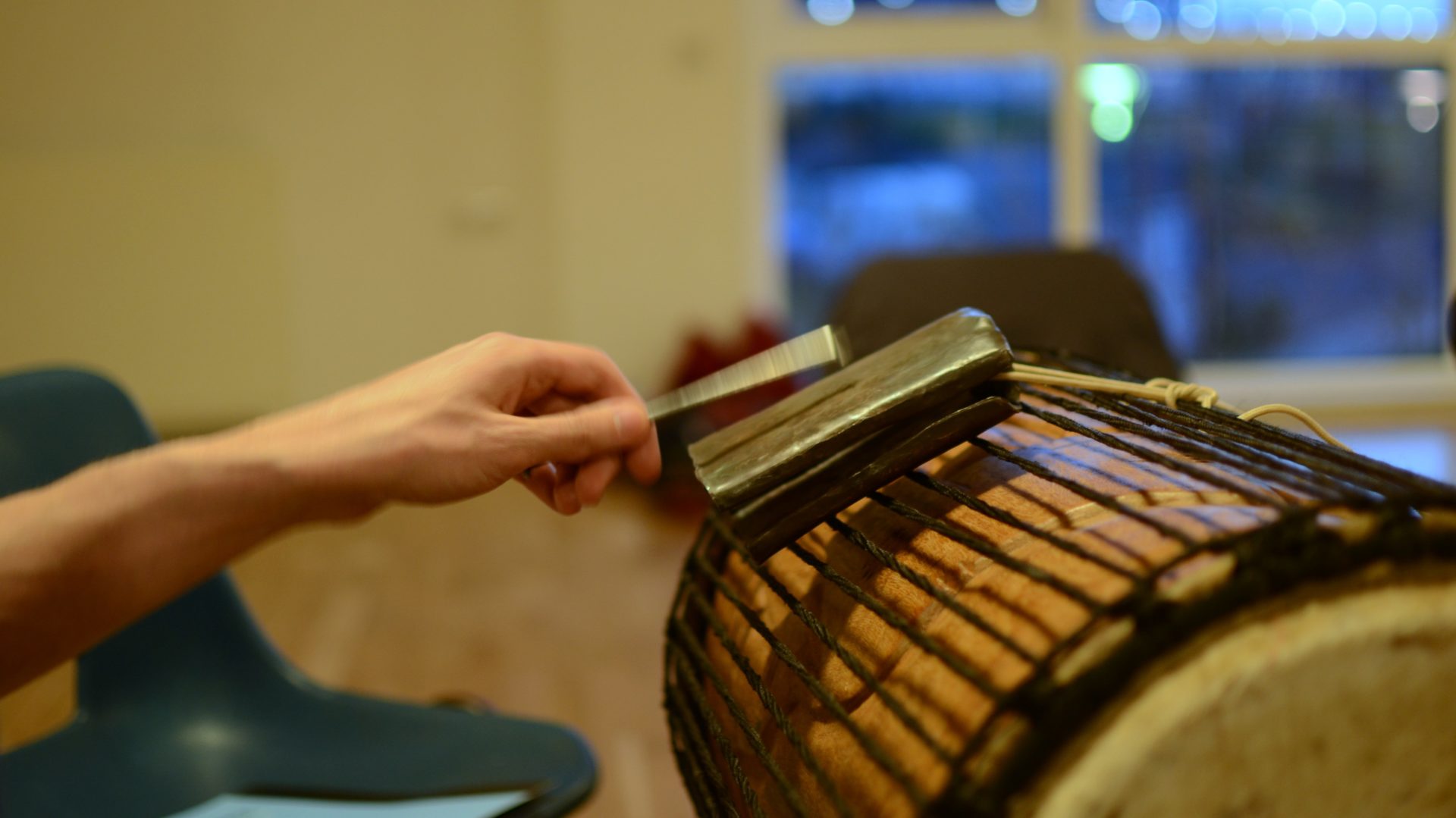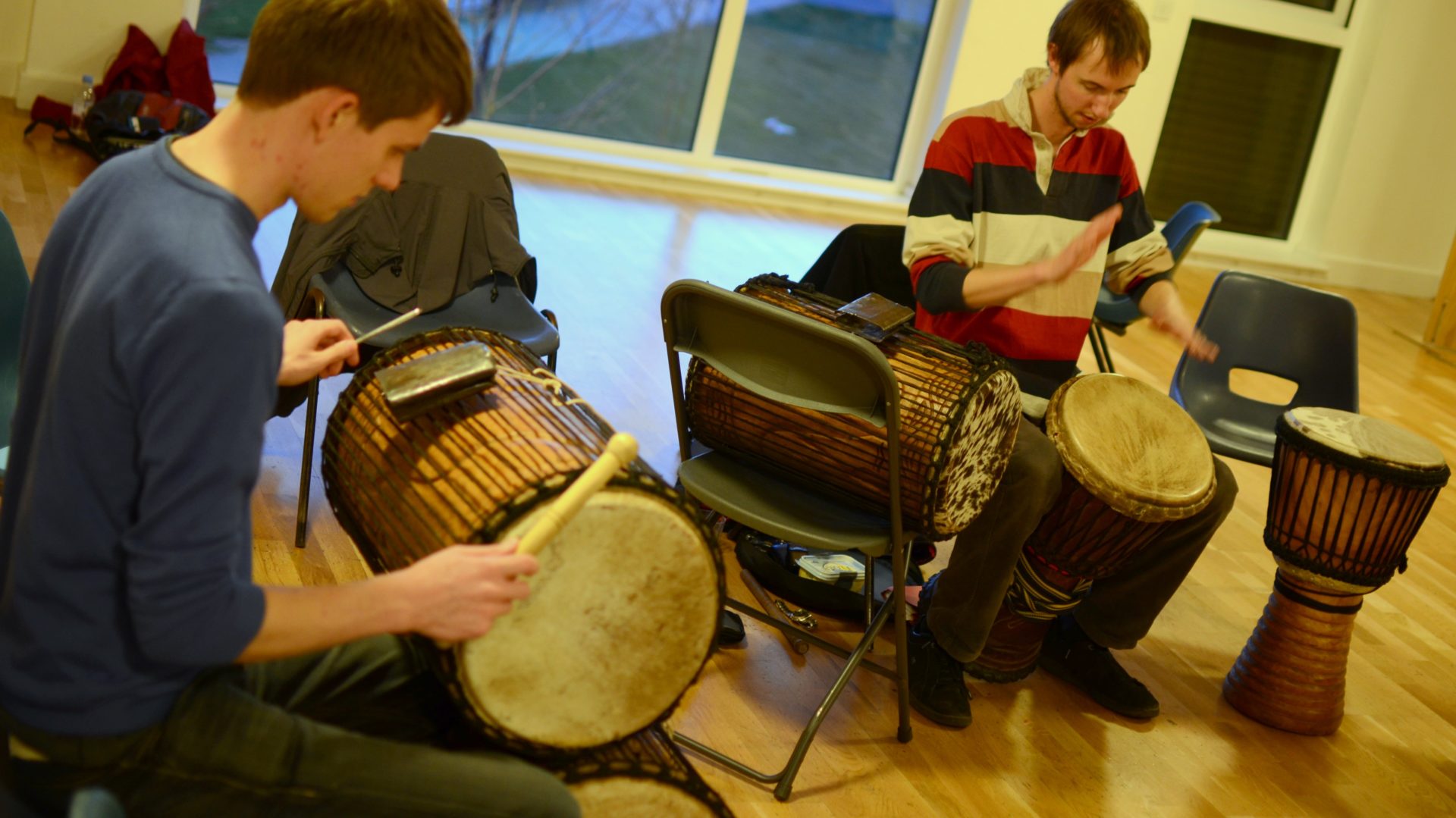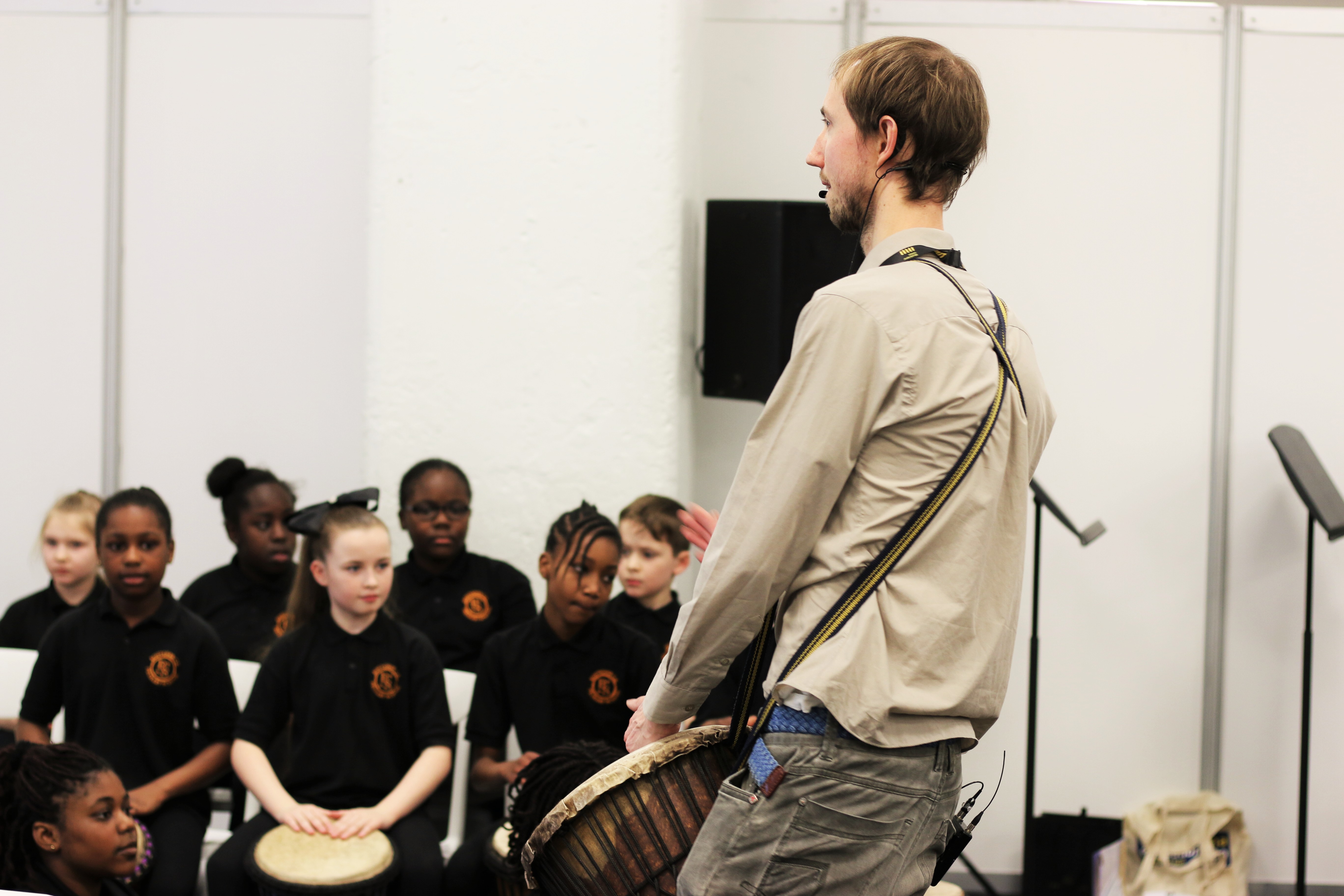Brazil!
Out of Africa, 7th – 31st January 2015
I have come to north-east Brazil for 6 weeks of drumming, music-watching, beach-lying and carnavalling, and in particular to see a culture of music and dance out of Africa that has stayed close to its roots. Unlike folkloric music from elsewhere in Brazil, such as samba which fuses African rhythms with more typically European musical elements, you can hear the African purity in the unaccompanied rhythm and voices of maracatu in Pernambuco.
– Frevo –
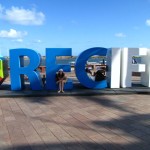
Monica and I chose a somewhat ill-advised root to Recife (‘Heh-see-fee’), picking the cheapest flight on sky scanner which managed to stretch our journey out to almost 26 hours, courtesy of a right-angled approach and a 6-hour stop off in Miami. So after a couple of days spent recovering and getting our bearings, we headed to Recife Antigo (the ‘old town’) to find some live music on a Saturday night. What we mainly found were blocos performing frevo music. The blocos consisted mainly of old middle-class women, with 3 or 4 aging singers singing in (almost) unison accompanied by snare drum, surdo (bass drum), pandeiro (tambourine), bass, cavaquinho (small 4-stringed guitar), and a horn section of saxophones, clarinet and flute.
Over the next couple of weeks we would stumble across frevo parties in pracas all over the city as the blocos prepare for carnaval. Generally though, we wouldn’t stay for long as it is probably the kind of music you need to remember from your childhood in the 1930s to enjoy. The women dress in shiny costumes, the colour of which varies from bloco to bloco. They hold brightly coloured small umbrellas and step casually from foot to foot as they sing along with the interminably cheerful and predictable songs. The lyrics tend to refer to the greatness of frevo and the alegria (joy) it brings to their lives, which is nice enough – but unfortunately the musicianship involved isn’t quite deep enough to hold even some of the bands’ own interest.
Frevo, to an outsider, feels like the kind of music you might find in a totalitarian state like North Korea, where the melodies and lyrics are so relentlessly cheerful and exultant as to be empty and soulless. However, I’m sure those taking part are enjoying themselves while praising their Dear Frevo, and it is good that the older generation have a type of carnaval music that they feel is their own and which binds them together – that is what music is for!
– Forro –
Our first Saturday night in Recife was a tad disappointing, having left the hostel anticipating a party spirit on the streets and live music in every bar, it felt a little understated and flat with very little live music to be heard besides the frevo. However, on Sunday afternoon we were advised that a band called Grupo Bongar were performing in Praca do Arsenal in the old town, so we set off for the centre again with renewed hope.
In the company of my friend Roberto, a law graduate from Recife who I met at a hostel in Paris 3 years ago, and his fiancee Gabriella, we found the praca (square) where the band were already mid-set. Their music was Afro-Brazilian, and was much more like the quality I had come to Brazil to see, although Roberto and I spent much of their set searching for caipirinhas. After they finished, the regular Sunday night band took over to perform their weekly forro (‘foh-HOH’).
Forro is a type of music from the countryside of north-east Brazil. It accompanies a dance for couples, where the man and woman dance in very close proximity while stepping on beats 3, 4 and 1. There is some variation in the tempo and style played by the zambumba (bass drum), large triangle and accordion with mainly lydian and mixolydian mode songs. Baiao is the original style of forro, but they also play coco (my favourite), a slower style called xote and the fastest, arrasta-pe.
The zabumba provides most of the rhythmical variation, using a large headed beater on the top and a thin plastic stick on the bottom to create the syncopated rhythms that characterise each particular dance. The triangle plays all the divisions of the beat constantly without variation, outlining the feel with an open sound on the off-beat and closed notes on all other divisions of the beat while also most obviously providing the 4-note swing (see intermediate course archive for more about ‘swing’). The accordion plays all the harmony and melodic interludes, while the singing is often done in thirds, with lively syncopated melodic lines.
It is great fun, with a great energetic feel to it that serves the party well. Indeed the word forro comes from forrobodo, a Portuguese word used to describe a crazy party! All the musicians we’ve seen performing forro pe-de-serra have a rugged, tanned, strong-armed countryside look to them and have clearly been brought up with forro in a folk tradition.
The best context for forro we experienced was in a bar in Pipa (a village in Rio Grande do Norte which boasts idyllic beaches frequented daily by wild dolphins), which publicised forro pe-de-serra night on Sundays. We went along at 8pm to see if it had started – and found the bar completely deserted and were informed by the solitary barman that it would start at 10pm. We went back at 10pm to find an old couple had arrived, but still no one else… and no sign of musicians. A third visit at 10:30pm saw the arrival of the musicians, and a few more people. By 11pm the place was completely packed, with hardly any space to dance to the high-spirited tones of the forro musicians. The grooves were just too good to care if your feet were being stepped on by strangers right left and right again.
– Maracatu –
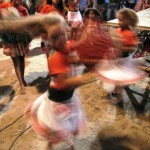
Maracatu is the reason we came to Recife. Recife and the adjacent town of Olinda are the centre of this folkloric music, which, like samba, is the music of the favelas (the poor, pre-dominently African neighbourhoods). It is slower than carnaval samba, and has a slightly smaller group of drummers – but still 50-60 more than your average rock band, as opposed to the 300 you find in the sambadrome.
We saw our first maracatu in the middle of the street in Recife Antigo, a bloco called ‘Paranambuca’, who were fairly good – but as a ‘bloco’ (which I have come to know is a code word for middle-class community group, rather than genuine working class folk musicians) I knew there would be much better to come.
Indeed the following evening I had managed to track down the rehearsal venue for Nacao do Maracatu Encanto do Pina in Pina, which was less than a 15 minute walk from our hostel. Roberto was dubious about the neighbourhood, so drove us there to check it out in the afternoon. When we turned left off the main road it was like shifting from one continent to another. All of a sudden we were surrounded by dirt track, shanty houses, and young boys in tatty second hand clothing on bikes and scooters – a scene that took me back to the urban sprawl of Conakry in Guinea or Accra in Ghana. Every other building was an improvised Evangelical church, and where some contained deafeningly loud preachers, screaming down unnecessary microphones to a dozen or so faithful – others looked like they’d not hosted a service for decades.
After stopping several times for directions, we were eventually pointed by some old world-weary women to Mestra Joana. She was a woman in her 30s of Afro-Brazilian descent with an attractive glint in her eye, and she was the leader of the group. She handed us her card and told us we were welcome to come back to see their rehearsal at 8pm. So at 8pm, after dark, we were led down a dark back alley, through a house filled with costumes and head dresses, and into a back yard brimfilled with drummers. We managed to cram onto a bench by the door where I sat next to a 5-year-old boy called Joao, who turned out to be Joana’s son, with a timba (hand drum) strapped to him.
The sound of the group, who were led by Mestra Joana over a feedback-riddled PA, was immense. 20 or so alfaias (yet another type of bass drum) played the characteristic lilting off-beat bass rhythms while the single tarol (snare drum, played by Joana’s 14-year-old daughter) provided the feel and swing; two timbas played by teenagers with incredibly hard hands started off and kept a groove with occasional djembe-like soloistic variation; a gongue (huge cowbell) played and embellished the key-rhythm (what the Cubans would call clave); and the 10 shekeres, played by teenage girls, played the deafening tsh tsh-ka-tsh tsh-ka-tsh with hard swing while twirling around on the spot with steps forwards, backwards, left and right. Mestra Joana sang some unusual modal songs in call and response with the drummers, who heartily sang back over the din of drums. This is exactly what I had come to see!
All the while, Joao, the 5-year-old, was keeping up (and even starting off on his own) the synocpated timba grooves, his tiny hands willing the drum to speak its piercing slaps and meaty tones. I couldn’t believe that such accomplished sounds and confident grooves could come from such a small boy – even occasionally playing around with the beat and setting off on fast complicated variations, it demonstrated folk-learning at its best. The improvisation of the high-pitched timba drums sound so much like the music of their djembe-playing African cousins in Guinea and Mali, it is easy to see the parallels between this music and the cultural music and dance brought over by the slaves from Africa.
We managed to see a further example of the folk-learning process when Mestra Joana stopped the whole group mid-song, and pointed to a young 11-year-old boy who had played a note when he shouldn’t have played. She then told him to give up his seat for another boy and he sat out the rest of the rehearsal. If you can’t play properly – you must sit and listen until you understand, at which point you may try to play again.
Over the next week and a half we tracked down rehearsals for Nacao do Porto Rico (with many of the same players as Encanto do Pina), saw the famous Nana Vasconcelos rehearse on a timpani (kettle drum) with Nacao Estrela Brilhante do Recife and Nacao Almirante de Forte. At one Saturday night rehearsal in Pina, we saw Porto Rico rehearsing with Nana Vasconcelos and his female singers on the street, and afterwards rehearsing their own set. At about 10pm we spotted a tiny little boy, who could have been no older than 3 years old, playing a miniature alfaia while looking incredibly non-chalant and sleepy. He was playing exactly the arrangement in perfect sync with his older band members. Truly mind-blowing!
– Travels –
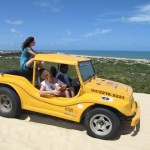
After 11 music-filled days in Recife, we travelled around the north-east to see the other cities and tourist hot-spots of the region including Porto de Galinhas (Harbour of Chickens) where we saw sea-horses, Natal (in Rio Grande do Norte) where we rode in a buggy sliding up and down sand dunes, Pipa where we swam with dolphins, and Joao Pessoa (in Paraiba) the most attractive colonial-built city we’ve seen here.
Now we are back near Recife, in a historic town called Olinda, to learn some maracatu dancing and drumming with the Mestres of Nacao Camaleao and Nacao Pernambuco and take part in carnaval. Watch out for my next blog entry to see how we get on!

